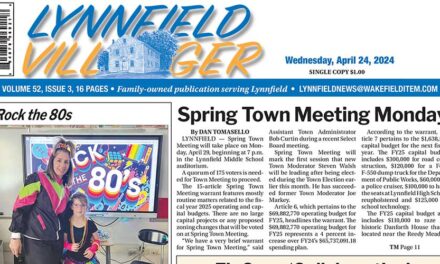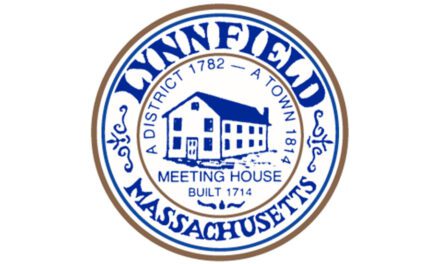Published in the December 2, 2015 edition
By MAUREEN DOHERTY
LYNNFIELD — The town will maintain its classified tax rate for fiscal year 2016 following a 2-1 vote of the Board of Selectmen Nov. 30
The tax rate will increase slightly for residential property owners by one cent to $14.50 per thousand. The average single family home property value increased by 2.2 percent from FY ’15 to FY ’16, which means the average residential tax bill will increase by about $183, from $8,030 last fiscal year to $8,213 in the current fiscal year, which began July 1, 2015.
The “average” assessment of a single family home in town has increased to $566,365 from $544,173, an increase of $12,192.
The percentage of the change in the taxes when comparing FY ’15 to FY ’16 averages 2.28 percent. There will be fluctuations in the average tax bill property owners receive based on numerous factors. For example, the value of colonial style homes in a particular neighborhood may increase at a faster pace than a ranch style home in the same neighborhood.
On the commercial, industrial and personal property (CIP) side of the ledger, the tax rate will increase by 39 cents per thousand of valuation, from $17.29 to $17.68. This means the average CIP tax bill will also increase by 2.28 percent.
Based on an average CIP property value of $2,228,118, the average tax bill will increase by about $879, from $38,524 in FY ’15 to $39,403 in FY ’16.
According to figures provided by Town Administrator Jim Boudreau, the total value of the town’s 137 CIP parcels increased by $40,013,907 or 13.1 percent, to $345,266,131 in FY ’16 compared to $305,252,231 in FY ’15.
The residential new growth totaled $7,348,900, which is an increase of 2.5 percent, to $2,179,356,775 for the town’s 3,835 residential parcels when compared to the FY ’15 valuation of $2,125,252,375.
However, new growth is always subtracted for the purposes of calculating the tax rate.
Both new tax rate increases of 2.28 percent reflect less than the 2.5 percent maximum increase in the levy allowed under Proposition 2 ½.
These tax rates must be certified by the state Dept. of Revenue (DOR), which will check the town’s math.
Residential shift maintained
The bulk of the discussion of Monday night’s meeting centered on balancing the percentage of the tax burden shift between residential and commercial property owners.
Retired Assessing Manager Dick Simmons made his final presentation to the Selectmen Monday night and introduced his successor, Raymond Boly, who was recently hired by the Board of Assessors.
Simmons said the decision before the board, which is revisited annually, is whether to continue “shifting the tax levy off of residential properties and onto commercial properties.” This is a practice that was first adopted by the town in FY ’04 because residential property tends to rise in value more quickly than commercial, which can result in a significantly higher tax burden for homeowners in towns like Lynnfield that have such a small commercial and industrial tax base.
Currently, 86.2 percent of Lynnfield’s property is classified as residential while the CIP split is 11.9 percent as commercial, 0.68 percent classified as industrial and 1.18 percent taxed as personal property.
Simmons stated, “One major misconception that has occurred over time is that this (shift) allows a community to increase the levy, when in fact it does not. Classification only allows the tax burden to be shifted within the constraints of the existing levy.”
He added that during the past 13 years since classification was adopted, “The shift has gone up and down in an attempt to mirror the interplay between commercial and residential values.”
The state DOR allows a shift factor of 1.0, which is equal to no shift, up to 1.5. Any increase or shift onto one class of property is increased or decreased “commensurately” onto the other side, Simmons said.
The Board of Assessors makes the recommendation to the Board of Selectmen based on the certified figures the DOR provided to them, but the final decision whether to make the shift and the percentage of the shift is legally the domain of the selectmen, Simmons said.
Simmons added that once a classified tax rate is adopted by a community, it becomes “extremely difficult to return to the past practice of a single rate” because the result would be “a startling decrease in the average commercial tax bill and a noticeable increase in the average residential tax bill.”
Public comments
During the public comment portion of the meeting, resident Pat Campbell attempted to raise a variety of questions about the town’s spending habits and the “waste” she sees in the town’s budget. Selectmen Chairman Phil Crawford explained that these questions were not within the bounds of the purpose of this public hearing, which was only to set the property tax classification and the allocation of the levy among the property classes.
Budget summit Dec. 9
Crawford explained that Campbell’s budget questions and those of any other residents or property owners would be welcomed by the board starting at next week’s budget summit on Wednesday, Dec. 9 at the Senior Center at 7 p.m. He added that discussions on the town budget would continue “for the next five months” at board meetings leading up to the annual Town Meeting in April.
Assessor Richard O’Neil concurred and invited Campbell to a meeting of his board to discuss any concerns she had regarding tax classification, which she welcomed.
Resident James Quinn commented that he believes the differential between the commercial and residential tax rates should be “double or triple” current rates. He said he owns commercial property in Burlington where that is the case and the businesses do not leave town because of it.
O’Neil disagreed, stating the savings to residents would be negligible but the effect on the smaller mom and pop type stores would be significant.
T.A. Boudreau reminded those present that the town budget for FY ’16 had already been set based on appropriations voted on at Town Meeting in April 2015 and October 2015. The decision before the board was merely how to divide up the tax obligations of that pie between the residential and commercial taxpayers.
Selectman Chris Barrett concurred, stating, “We have decided already as a town” how to spend the money on the various town budgets.
The town’s FY ’16 obligations total $40,906,039. The maximum levy allowed under Prop. 2 1/2 is $40,922,209 which leaves an excess capacity of $16,169 on the table, Simmons said.
The town’s total taxable valuation is $2,738,317,688, according to Simmons, which is divided between a residential valuation of $2,360,823,073 and a CIP valuation of $377,494,615.
If the tax rate were to remain flat between the classes, the residential homeowners would be footing 86.2 percent of the tax bill, Boudreau explained. Under the split tax rate, the commercial property owners shoulder a little bit more of that obligation.
To arrive at the average increase of 2.28 percent in the tax bills for both residential and commercial property owners, it was determined that a residential shift factor of 0.970626 needed to be adopted.
Barrett moved to adopt that figure “for the purpose of setting the FY 2016 property tax rates with no exemptions.” It was seconded by Crawford after Selectman Tom Terranova declined to offer a second.
“I can’t agree with that. I think we need to do more of a shift. Although I think the point that Mr. Quinn was making maybe didn’t come out clear,” Terranova said, adding that he agreed with Quinn’s premise and felt a shift should be made “from the residents carrying the burden to getting a little more assistance from the commercial side. So I can’t second that.” The vote passed 2-1.
No special exemptions made
The selectmen chose not to establish a residential tax exemption that would have shifted the burden from lower valued owner-occupied properties to higher valued properties that are not the principal residence of a taxpayer.
The board also chose not to establish a small commercial tax exemption intended to benefit small business parcels valued at less than $1 million that also employ fewer than 10 people.




